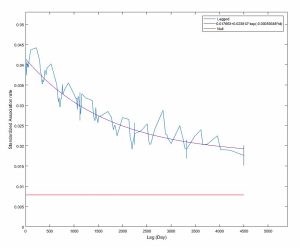
DCP is very excited about our poster presentation at the World Marine Mammal Conference in Barcelona, Spain. Lead author and long-time DCP assistant/student, Nicole presented our work on associations among the spotted dolphins off Bimini. If you saw the poster in person, thank you for your interest in learning more!
Abstract:
This study is the first to investigate the social patterns of a population of Atlantic spotted dolphins (Stenella frontalis) off Bimini, The Bahamas, during a 14-year period (2003-2016). We generated association indices and conducted cluster, network, and temporal analyses using SOCPROG 2.8. Dolphins in this group display long-term, year-round residency around Bimini, as well as long-term preferences in association with a combination of rapid disassociation, constant companions, and casual acquaintances. We found no evidence of distinct social clusters within the study group; however, we discovered at least one subgroup of males with higher association than the rest of the population. Despite strong relationships between males, we found no evidence for the existence of alliances or coalitions. Bimini spotted dolphins do not experience the same social forces thought to drive such supportive relationships in other study groups; they do not experience repeated aggressive interactions with sympatric bottlenose dolphins (Tursiops truncatus), nor are males limited in their access to females.
Effort info:
Over the course of this 14-year study, we completed 804 boat trips in search of dolphins. This resulted in 3,609 hours of search effort. On 628 (78.1%) of those boat trips (“surveys”), we saw dolphins from the boat and this resulted in 1,609 separate dolphin sightings. On 524 (65.2%) we were able to observe them under water at least once, and we actually had 873 underwater observations.
Take away lesson:
The Bimini Atlantic spotted dolphin social network is characterized by fission-fusion dynamics. Dyads form long-term preferential associations lasting years, especially between same-sex pairs.
Fun stuff:
A group of five male dolphins had the highest association throughout the study period (2003-2016). These males are similar in age and have been observed consistently since 2003. You might know them as Buster (#04), Split Jaw (#22), Prince William (#64), Tim (#69) and Speedy (#78). Split Jaw and Prince William have the highest strength of association over the full 14-year period (.68, where 1 would mean they were together all the time).
Another way of looking at things:
In this graph, you see the standardized lagged association rates for all individuals (2003-2016). Basically, this tells you the probability of seeing a pair together after a given amount of time. The technical stuff is: moving average was set to 50,000 associations; standard errors were calculated by jackknifing over 30-day periods. Best-fitted model was combination of “rapid disassociation” (within one sampling period), “constant companions” (social units that associate permanently), and “casual acquaintances” (social units disassociate but may preferentially re-associate). If this is interesting to you, make sure you grab a copy of the full paper when it’s published.
Why might dolphins form associations rather than just associate at random?
Preferred associations may improve foraging success or predator defense in deep Gulfstream waters. Or, preferences may have developed in early life from joint membership in mother-calf groups.
This work has just been published in the peer-reviewed journal, acta ethologica. Click here to access it or jot us an email.
